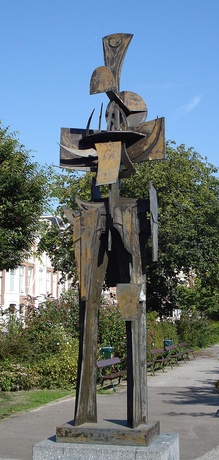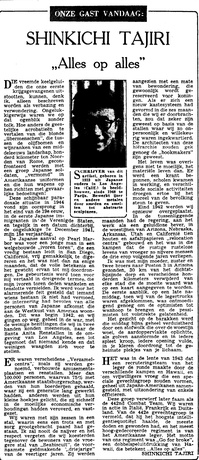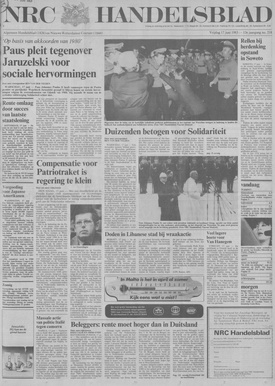On the morning of Friday, October 30, 1992, readers in the Netherlands opened copies of the NRC Handelsblad, one of the largest papers circulated in the country. The front page commemorated twelve and a half years of Queen Beatrix’s reign, and page 3 shows a grinning George HW Bush in Michigan for a speech on the 1992 campaign trail. Reports on the brewing war in Bosnia circulated throughout, showing the plight of civilians as they moved through bombed-out neighborhoods. For Dutch audiences in 1992, all this must have felt rather familiar.
However, on the front page of the weekly cultural supplement was a striking picture of two Japanese American women holding service flags, with the caption reading “Japanese American women at the Heart Mountain Relocation center.” The tile of the accompanying article, “Above the barracks rises Mount Fuji: Discord in the concentration camps for Japanese-Americans,” summarizes its overall topic: the story of the Japanese Americans sent to camp and their artwork.1 The article included references to the UCLA camp art exhibit “Views From Within” and to John Okada’s pioneering novel No-No Boy. It might seem remarkable that audiences in the Netherlands could be interested in such a distant and sobering topic as the incarceration of Japanese Americans. Yet this was neither the first nor the last article to discuss the story in Dutch newspapers, and it forms part of a greater history of Dutch interest in Japanese Americans.
The relationship between the Netherlands and Japan is well-known and one of the oldest among European states. The Dutch were the only European nation to trade with the Japanese shogunate during the Tokugawa period, with ships working the port of Dejima in Nagasaki Bay, and helped facilitate scientific innovation through what became known in Japan as Rangaku (“Dutch learning”).
While relations declined following the opening of Japan by the U.S., Japanese art played a major role in the works of Dutch painters such as Vincent van Gogh. The height of tension between Japan and the Netherlands emerged following the invasion of the Dutch East Indies in 1942 by the Empire of Japan, and large numbers of Dutch civilians and Indonesians supportive of the Dutch were interned in camps throughout the war. Although the Dutch colonists imprisoned by the Japanese in camps faced brutal conditions, the discussion of their treatment cannot be divorced from the larger history of colonial violence inflicted by the Dutch upon Indonesia.
Still, leaving aside their Pacific interactions with Japan, the Dutch would seem on the surface to have very few connections with Japanese Americans. Yet the Nikkei were brought (literally) into the picture for the Dutch by the presence of numerous expatriates amid by the unique art communities of the Netherlands. The most notable example was the Nisei sculptor Shinkichi Tajiri—the brother of the famed editor Larry Tajiri of the Pacific Citizen—who first moved to the Netherlands in 1956, and resided in Baarlo in 1962 until his death in 2009 and achieved nationwide renown.
To this day, many of his sculptures are featured across the Netherlands, such as his Wachter (“Watcher”) sculpture in the Hague, inspired by the story of the 47 Ronin. In a 1955 interview with Het Parool (The Motto), Tajiri reflected on his camp experience. As Tajiri explained it, the attack on Pearl Harbor—which came on the same day as his 18th birthday—shattered the “ivory tower” of life near San Diego, resulting in his confinement with his family at Santa Anita Assembly center and Poston Incarceration Camp.2

The Watcher in the Hague by Shinkichi Tajiri in The Netherlands by Wikifrits (Wikipedia.com)
|
In a 1958 interview, he informed Dutch readers that “of the hundred thousand interned over 75 percent were American citizens. Not one could be found guilty of espionage or sabotage.”3 Tajiri’s articles were some of the first accounts in Europe to document the experience of Japanese Americans during the Second World War, and without them it would be unlikely that Dutch readers would have encountered the story of Japanese Americans.
Beside Tajiri’s interviews, little mention is made during the 1960s and 1970s. A 1971 article in the Christian newspaper Trouw addresses student activism globally and government use of camps globally. In reference to the U.S., it cites Spark Matsunaga’s call to end the McCarran Internal Security Act of 1950.4
Twenty years later, the story of the camps would resurface regularly in the Dutch press with the advent of the redress movement. Following the establishment of the Commission of Wartime Relocation and Internment of Civilians in 1980, publications on the camps began appearing almost twice a year in major Dutch papers—coinciding with the major events of the Redress movement. In most cases, Dutch reporters referred to the camps as ‘interneringskampen,’ [internment camps] with some choosing the word ‘concentratiekampen’ [concentration camps]—the most vocal advocate of the use of “concentration camps” was the Dutch Reformed Church organ Trouw.
The articles generally were placed amid overseas news—in one case, in 1988, a short article on the passage of a redress bill by the House of Representatives appeared next to coverage of protests by Jewish survivors in France against a Holocaust denial speech by right-wing politician Jean-Marie Le Pen.5
One of the few times an article on the incarceration appeared on the front page was on June 17, 1983, when the CWRIC released its findings to Congress and called for paid redress to its survivors.6 While leftist newspapers such as NRC Handelsblad were willing to engage the subject and present the story in detail, the conservative De Telegraaf opposed passage of redress, with one article portraying reparations to Japanese Americans as unfair in the wake of the actions of the Japanese Army against the Dutch during World War II.7
In the years following Redress, references to the camp experience would continue to be featured in newspapers, even as films such as “Yankee Samurai” appeared on television.8 Interestingly, in 1991 NRC Handelsblad ran a set of reader letters discussing demands by Dutch citizens for reparations from Japanese government, in which redress was referenced.9 One reader suggested that the Japanese American case was different because it was a government offering compensation to its own citizens, rather than a question of inter-governmental demands. Ironically at the top of the article was a drawing of an eye with the rising sun flag of Japan done by Sansei artist Ryu Tajiri, the daughter of Shinkichi Tajiri.10
The reporting of the experiences of Japanese Americans in the Dutch press, and especially the redress movement, can be read in two ways. It can be seen as referencing a unique chapter in the saga of the Second World War, as part of a larger exploration of human rights by citizens of the Netherlands, a country that continues to play an important role in global truth commissions and hosts the International Criminal Court. Very few European countries circulated reports on the redress movement as much as the Netherlands, with very few articles appearing in French or British papers. At the same time, by offering another perspective on the redress of grievances and the broader question of citizenship, the story of Japanese Americans offers the Dutch a window to reappraising their own colonial history and treatment of Indonesians.
Today, the rise of conservatism and anti-immigration sentiment in European states like the Netherlands is a sobering reminder that the lessons of the incarceration are not limited to the United States, but offer an important lesson for other nations. Dutch interest in the subject provides Americans an opportunity to address the nation’s own failures and struggles over equality as a way of furthering the cause of openness and acceptance.
Notes:
1. Jan Donkers, “Boven de barakken zweeft de berg Fuji,” NRC Handelsblad, October 30, 1992.
2. “De Japanse aanval op Pearl Harbor was voor en jonge man in een welgebouwde "ivoren toren," die een vredig bestaan leidt in San Diego, vrij gemakkelijk te digereren en het was niet dan na enige maanden, dat de volle beteknis en het gewicht ervan tot mij doordrongen. De gebeurtenis werd toen voor mij vertaald in dreigende termen, die mijn ivoren toren deden wankelen en tesnlotte vernielden. Ik werd voor het alarmerende feit gesteld dat iemand wiens bestaan ik niet had veroed, de internering had bevolen van alle personen van Japanse afkomst die aan de Westkust van Amerika woonden.” “Alles voor Alles,” Het Parool, May 11, 1955
3. “Van de honderdduizend geïnterneerden bezat 75 percent het Amerikaanse staatsburgerschap. Niet een van die mensen heeft men een daad van spionage of sabotage ten laste kunnen leggen, zegt hij.”Het Vrije Volk, March 27, 1958.
4. “Tijdens de hoogtijdagen van het studentenprotest in Amerika gingen er in het jamp van de buitenparlementaire oppositie de geruchten dat de regering van plan was politieke activisten over te brengen naar concentratiekampen. Het gerucht was niet waar, maar de mogelijkheid bestond wel. Het congres gaf - ondanks een veto van de president - in 1950 de regering namelijk de macht Amerikanen in gevangenkampen te plaatsen en er werden zelfs ze van deze kampen gebouwd. Deze wet is niets meer - en miets minder - dan een concentratiekampwet. riep afgevaardigde Spark uit, die het hoog tijd vindt deze gevaarlijk wet in te trekken en daarbij de steun heeft van 160 collega's. De boosheid van Matsunaga is te begrijpen want hij was een van de 110000 Amerikanen van Japanse afkomst, die tijdens de tweede wereldoorlog in relocatie-kampen bijeengedreven werden.” “Globaal gezien,” Trouw, November 12, 1971.
5. “Voormalige geïnterneerden in VS mogen schade claimen.” NRC Handelsblad, January 22, 1986.
6. “Vergoeding voor Japanse-Amerikanen.” NRC Handelsblad, June 17, 1983.
7. “Stichting eist 20.000 dollar voor Japan slachtoffers,”De Telegraaf, October 25, 1990.
8. “Yankee Samurai,” De Telegraaf, August 25, 1985.
9. “Brieven,” NRC Handelsblad, March 31, 1991.
10. Ibid.
© 2019 Jonathan van Harmelen








